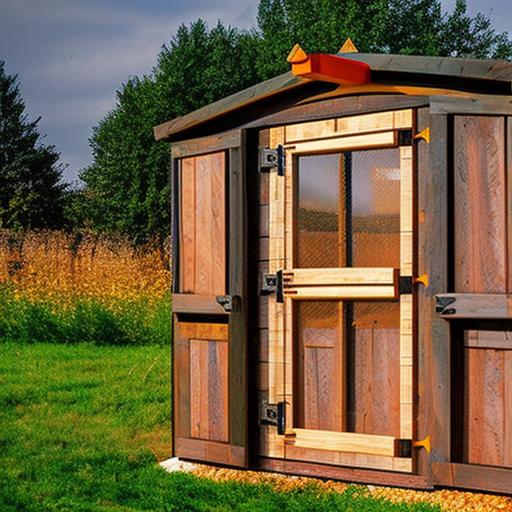Chicken coop doors are an essential component of any backyard chicken coop. They serve multiple purposes, including providing security for your flock, regulating temperature and ventilation within the coop, and allowing easy access for both chickens and humans. Choosing the right size for your chicken coop door is crucial to ensure the safety and well-being of your chickens. In this article, we will explore the importance of selecting the correct size for your chicken coop door, factors to consider when making this decision, and the impact that door size can have on chicken health and safety.
Importance of Choosing the Right Chicken Coop Door Size
Selecting the right size for your chicken coop door is vital for several reasons. Firstly, the wrong size can lead to safety issues for your chickens. If the door is too small, chickens may struggle to enter or exit the coop, potentially causing injuries or stress. On the other hand, if the door is too large, it may allow predators or other animals to enter the coop, putting your flock at risk.
Secondly, the size of the chicken coop door can affect ventilation and temperature control within the coop. A door that is too small may restrict airflow, leading to poor ventilation and increased humidity levels. This can create an unhealthy environment for your chickens and increase the risk of respiratory diseases. Conversely, a door that is too large may result in excessive drafts during colder months, making it difficult to maintain a comfortable temperature inside the coop.
Factors to Consider When Selecting a Chicken Coop Door Size
When choosing the size of your chicken coop door, there are several factors you should consider. Firstly, you need to take into account the size of your flock. If you have a large number of chickens, you will need a larger door to accommodate their movement in and out of the coop. Conversely, if you have a small flock, a smaller door may be sufficient.
Additionally, you should consider the size of your coop itself. The door should be proportionate to the overall size of the coop, ensuring that it fits seamlessly and provides easy access for both chickens and humans. If your coop is small, a large door may take up too much space and make it difficult to navigate inside. Conversely, if your coop is large, a small door may cause congestion and make it challenging for chickens to enter or exit.
Lastly, the climate in your area should also influence your decision. If you live in an area with extreme temperatures, such as very hot summers or cold winters, you may need to choose a door size that allows for better temperature control. For example, in hot climates, a larger door may help promote airflow and prevent overheating, while in colder climates, a smaller door may help retain heat.
The Ideal Height for a Chicken Coop Door
The height of the chicken coop door is an important consideration when selecting the right size. The ideal height will depend on several factors, including the size of your chickens and the ventilation needs of your coop.
A door that is too low can pose safety risks for your chickens. They may have to crouch or squeeze through the door, which can lead to injuries or stress. Additionally, a low door may restrict airflow and ventilation within the coop, leading to poor air quality and increased humidity levels.
On the other hand, a door that is too high may make it difficult for chickens to access the coop. Chickens are not natural flyers and may struggle to reach a high door. This can result in frustration and potential injuries as they attempt to enter or exit the coop.
The ideal height for a chicken coop door is typically around 12-18 inches above the ground. This allows for easy access for chickens while still providing adequate ventilation and temperature control within the coop.
The Optimal Width for a Chicken Coop Door
The width of the chicken coop door is another important consideration when choosing the right size. The optimal width will depend on the size of your chickens, as well as the ease of access for both chickens and humans.
A door that is too narrow can make it difficult for chickens to enter or exit the coop. They may have to squeeze through, potentially causing injuries or stress. Additionally, a narrow door may make it challenging for humans to access the coop for cleaning or maintenance purposes.
On the other hand, a door that is too wide may allow predators or other animals to enter the coop. It is important to strike a balance between providing easy access for chickens and maintaining security for your flock.
The optimal width for a chicken coop door is typically around 12-16 inches. This allows for easy passage for chickens while still providing a secure barrier against predators.
The Best Material for a Chicken Coop Door
When it comes to choosing the material for your chicken coop door, there are several options available, each with its own pros and cons.
Wooden doors are a popular choice due to their durability and natural aesthetic. They provide good insulation and can withstand various weather conditions. However, wooden doors may require regular maintenance, such as sealing or painting, to prevent rotting or warping over time.
Metal doors, such as aluminum or steel, are another option. They are sturdy and resistant to damage from predators or harsh weather conditions. Metal doors are also easy to clean and maintain. However, they may not provide as much insulation as wooden doors and can become hot or cold depending on the temperature outside.
Plastic doors are lightweight and easy to install. They are resistant to rotting and require minimal maintenance. Plastic doors also provide good insulation and can withstand various weather conditions. However, they may not be as durable as wooden or metal doors and can become brittle over time.
Ultimately, the best material for your chicken coop door will depend on your specific needs and preferences. Consider factors such as durability, insulation, and maintenance requirements when making your decision.
Types of Chicken Coop Doors Available in the Market
There are several types of chicken coop doors available in the market, each with its own advantages and disadvantages.
Traditional hinged doors are a popular choice for chicken coops. They are easy to install and provide a secure barrier for your flock. Hinged doors can be made from various materials, such as wood or metal, and can be customized to fit your specific needs. However, they may require regular maintenance to ensure smooth operation and prevent rusting or warping.
Sliding doors are another option for chicken coops. They are space-saving and provide easy access for both chickens and humans. Sliding doors can be made from various materials, such as wood or plastic, and can be operated manually or with the help of a motorized system. However, they may require more complex installation and maintenance compared to hinged doors.
Automatic doors are becoming increasingly popular among chicken keepers. These doors are equipped with sensors or timers that automatically open and close at specific times. Automatic doors provide convenience and security, especially for those who cannot be present to manually open and close the coop door every day. However, they may require additional setup and maintenance, such as battery replacement or programming.
When choosing the type of chicken coop door, consider factors such as ease of use, security, and your personal preferences.
How to Measure Your Chicken Coop Door Size
Measuring your chicken coop door size accurately is crucial to ensure a proper fit. Here is a step-by-step guide on how to measure your coop door:
1. Measure the height: Start by measuring the height of the opening where you plan to install the door. Measure from the bottom of the opening to the top.
2. Measure the width: Next, measure the width of the opening. Measure from one side of the opening to the other.
3. Consider clearance: Take into account any clearance requirements for the door to open and close smoothly. Leave a few inches of clearance on each side and at the top to ensure proper operation.
4. Note any obstructions: If there are any obstructions, such as windows or nesting boxes, near the opening, make sure to measure around them and account for their presence when selecting the door size.
By following these steps, you can ensure that you choose the right size for your chicken coop door.
The Impact of Door Size on Chicken Health and Safety
The size of your chicken coop door can have a significant impact on the health and safety of your flock. Choosing the wrong size can lead to injuries, stress, and unhealthy behavior among chickens.
If the door is too small, chickens may struggle to enter or exit the coop. They may have to squeeze through, potentially causing injuries or stress. This can lead to behavioral issues, such as aggression or feather picking, as chickens become frustrated with limited access to the outside environment.
On the other hand, if the door is too large, it may allow predators or other animals to enter the coop. This puts your flock at risk of attacks or theft. Additionally, a large door may result in excessive drafts during colder months, making it difficult to maintain a comfortable temperature inside the coop.
Choosing the right size for your chicken coop door promotes healthy behavior and reduces stress among chickens. It allows for easy access to the outside environment, encourages natural behaviors such as foraging and dust bathing, and provides a secure barrier against predators.
Tips for Maintaining Your Chicken Coop Door
Proper maintenance is essential to ensure that your chicken coop door remains in good condition and functions effectively. Here are some tips for maintaining your chicken coop door:
1. Regular cleaning: Clean your coop door regularly to remove dirt, dust, and debris. This will prevent buildup and ensure smooth operation.
2. Lubrication: Apply lubricant to hinges, tracks, or any moving parts of the door to prevent rusting or sticking. This will ensure that the door opens and closes smoothly.
3. Inspect for damage: Regularly inspect your coop door for any signs of damage, such as cracks, warping, or loose screws. Repair or replace any damaged parts promptly to maintain the integrity of the door.
4. Weatherproofing: If your coop door is made of wood, consider weatherproofing it with a sealant or paint to protect it from moisture and rotting. This will prolong its lifespan and maintain its functionality.
5. Battery replacement (for automatic doors): If you have an automatic door, make sure to replace the batteries regularly to ensure that it continues to operate as intended.
By following these maintenance tips, you can keep your chicken coop door in good condition and extend its lifespan.
Cost Considerations When Choosing a Chicken Coop Door Size
Cost is an important factor to consider when choosing the size of your chicken coop door. The price will depend on various factors, including the size of the door, the material used, and any additional features or automation.
Generally, larger doors will cost more than smaller ones due to the increased materials required. Additionally, certain materials may be more expensive than others. For example, wooden doors may be more costly compared to plastic or metal doors.
If you opt for an automatic door with sensors or timers, expect to pay a higher price compared to manual doors. The additional features and technology involved in automatic doors contribute to their higher cost.
When choosing the size of your chicken coop door, it is important to strike a balance between your budget and the needs of your flock. Consider factors such as durability, functionality, and long-term cost savings when making your decision.
Choosing the Perfect Chicken Coop Door Size for Your Flock
In conclusion, selecting the right size for your chicken coop door is crucial for the safety and well-being of your flock. The wrong size can lead to safety issues, poor ventilation, and temperature control problems. When choosing the size, consider factors such as the size of your flock, the size of your coop, and the climate in your area.
The ideal height for a chicken coop door is typically around 12-18 inches above the ground, providing easy access for chickens while maintaining ventilation. The optimal width is usually around 12-16 inches, striking a balance between easy access and security.
When it comes to materials and types of doors, consider factors such as durability, insulation, ease of use, and personal preferences. Regular maintenance is essential to keep your chicken coop door in good condition and ensure its functionality.
Lastly, cost considerations should be taken into account when choosing the size of your chicken coop door. Strive to find a balance between your budget and the needs of your flock.
By carefully considering these factors and making an informed decision, you can choose the perfect chicken coop door size for your flock, ensuring their safety, comfort, and overall well-being.
Meet Walter, the feathered-friend fanatic of Florida! Nestled in the sunshine state, Walter struts through life with his feathered companions, clucking his way to happiness. With a coop that’s fancier than a five-star hotel, he’s the Don Juan of the chicken world. When he’s not teaching his hens to do the cha-cha, you’ll find him in a heated debate with his prized rooster, Sir Clucks-a-Lot. Walter’s poultry passion is no yolk; he’s the sunny-side-up guy you never knew you needed in your flock of friends!








